Cambrian RainScape (2017)
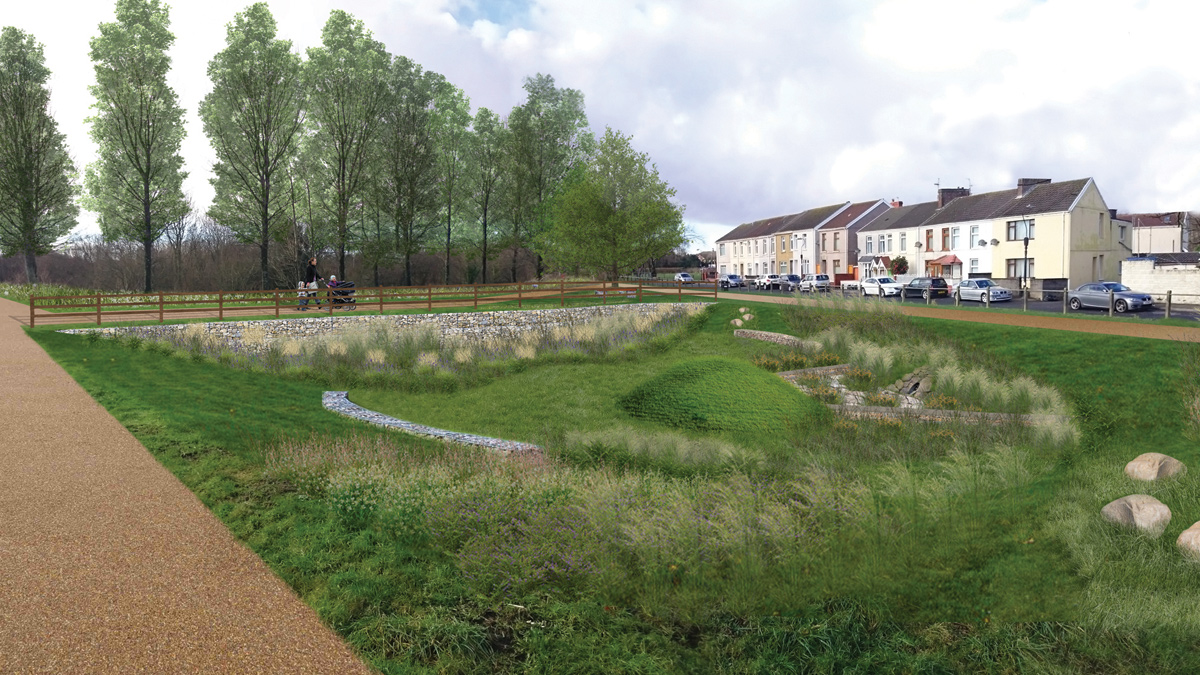
Cambrian North basin artist’s impression - Courtesy of Dŵr Cymru Welsh Water
The Cambrian catchment has a population of 4,500 and is located in Llanelli, South Wales. The catchment is predominantly served by combined sewers with a combined sewer overflow (CSO) at Cambrian Sewage Pumping Station (SPS). The CSO discharges approximately 52 times per year (54,000m3 per year) into the Loughor Estuary, a designated Shellfish Water. The National Environment Programme (NEP) places a requirement on Cambrian SPS to significantly reduce its intermittent discharges to only 10 per year by March 2020. To meet this target Dŵr Cymru Welsh Water has implemented a £7.9m catchment wide surface water removal and sustainable drainage systems (SuDS) solution. Arup and Morgan Sindall have delivered this work as part of Welsh Water’s Capital Delivery Alliance, closely engaging Carmarthenshire County Council, Natural Resources Wales and customers. Construction began in November 2015 and completion is programmed for July 2017.
Catchment background
To understand the existing Cambrian catchment, a hydraulic model of the sewer network and SPS was built. The combined outputs from 15 (No.) flow monitors, 6 (No.) rain gauges, a 16ha connectivity survey and long term telemetry data from Cambrian SPS informed the model. It confirmed that peak flows to the SPS reach in excess of 1,600l/s, in comparison to 10l/s of dry weather flow and a consented pass forward flow of 144l/s. This was the baseline scenario for which solutions were based on.
Optioneering and outline design
During the optioneering phase several approaches to meeting the NEP target were assessed using the hydraulic model.
- Traditional storage: Introducing 2,600m3 extra storage into the network was one option. However, in considering the wider catchment model, the team recognised that increased storage in Cambrian would increase the risk of discharges to Shellfish Waters downstream at Northumberland SPS and Llanelli WwTW. This is because a higher volume of water would be pumped downstream to already overloaded assets. It was also appreciated that this solution only offered limited resilience against deterioration, growth and changes in rainfall patterns.
- SuDS only: Another option was to introduce 2,600m3 of attenuation in the catchment by implementing SuDS. Several SuDS had been implemented in the wider Llanelli catchment in AMP5, which demonstrated the success of SuDS at reducing peak flow in the combined sewer (see Retro-fit Green Infrastructure in Llanelli, UK Water Projects 2014/15). However, the busy urban environment in the Cambrian catchment presents a different picture with less open space to implement enough SuDS to make it a viable option across the catchment.
- Surface water removal: Creating a new surface water sewer network alongside strategically targeted SuDS was a further option. This solution tackles the root cause of the problem by removing 10ha of the fast response impermeable surface from the combined sewer.
Using a risk and value whole life cost approach, the surface water removal option was identified for implementation, named Cambrian RainScape. This approach will remove 125,000m3 of surface water from the combined sewer and the pumping and treatment processes per year. As a result it will reduce energy usage, increase catchment resilience to flooding and climate change and reduce pressure on the major networks downstream.
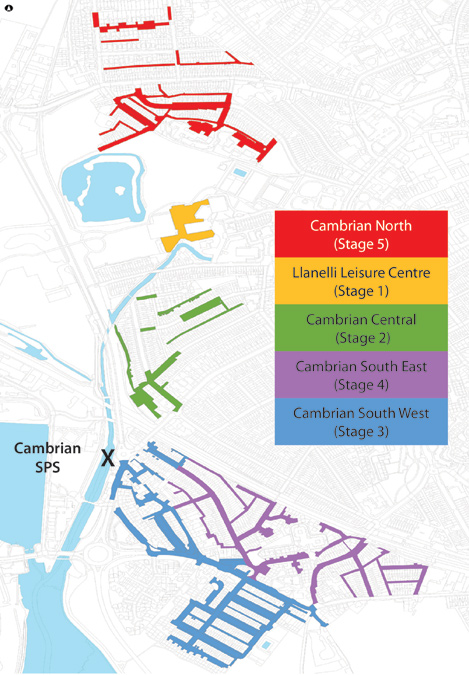
Figure 1: Cambrian RainScape Stages 1-5
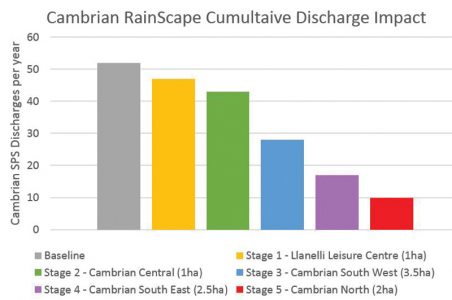
Figure 2: Graph of cumulative discharge impact of Cambrian RainScape Stages 1-5
Cambrian RainScape has been delivered in 5 stages: Llanelli Leisure Centre, Cambrian Central, Cambrian South West, Cambrian South East and Cambrian North (Table 1 below and Figure 1 above). Each stage contributes to reducing the discharges at Cambrian SPS to meet the NEP target (Figure 2). Stage 1 was delivered by Carmarthenshire County Council and Stages 2 to 5 have been delivered by Welsh Water.
Stage: Scheme: Construction Dates
- Stage 1: Llanelli Leisure Centre: Delivered by Carmarthenshire County Council
- Stage 2: Cambrian Central: 2/11/2015-22/4/2016
- Stage 3: Cambrian South West: 5/1/2016-2/9/2016
- Stage 4: Cambrian South East: 4/4/2016-23/12/2016
- Stage 5: Cambrian North: 25/7/2016 – June 2017
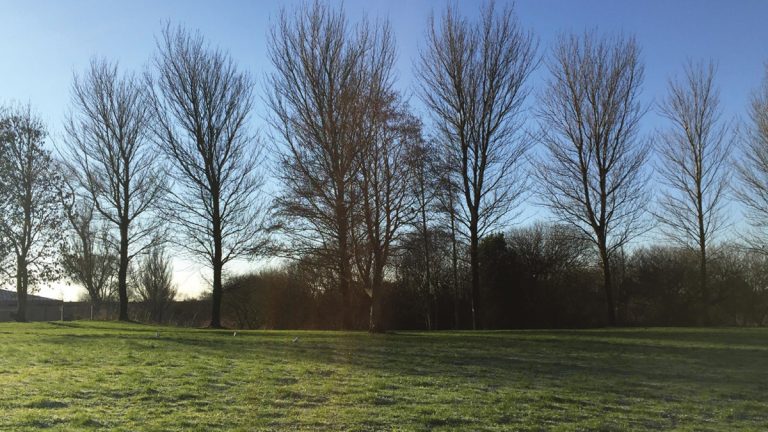
Site for Cambrian North basin before construction (February 2016) – Courtesy of Arup
Design opportunities and challenges
The 10ha of impermeable surface removal mainly consists of highways, large public buildings and private housing estates. Several opportunities reduced the scope and cost of the new surface water network. Through extensive CCTV and connectivity surveys around 2km of existing private, highway and Welsh Water surface water pipes have been utilised, saving on new pipework. Additionally only two new outfalls have been designed, as permission to utilise two existing outfalls was gained from the council and Welsh Water. A further opportunity has been realised where new Welsh Water surface water sewers have been designed, the resilience against local flooding has increased by protecting the highways for a 1 in 30 year storm, where previously many highway drains were undersized for a 1 in 5 year storm.
A major design element was the SuDS in Cambrian North. A SuDS was chosen to deal with the flows on site because the low ground level of the catchment and the 350m distance to a river meant discharging the flows to the River Lliedi was not financially viable. The SuDS catchment consists of 1ha of highway and private roof area. The glacial till, proximity to a landfill and high groundwater level meant a soakaway design was not feasible. To address this a lined basin was proposed in an unused open green area that would attenuate the flow and release it slowly into the combined sewer. The SuDS design delivers multiple benefits; adding amenity value, creating habitats, providing an opportunity for the public to engage with water management and improving linkages between existing cycleways. The design, planning and delivery was carried out in close partnership with Carmarthenshire County Council and careful engagement with local residents.
The constraints of the site provided several design challenges. The low ground level in the upstream catchment meant the incoming pipe to the basin was 2m below existing ground level. Therefore to achieve the desired 200m3 storage volume, a gabion wall was required along one side of the basin and nearly 3,000m3 of earthworks. Additionally, behind the row of trees on the site is a 6m deep pond with a level of 1.5m below ground level. The pond combined with the challenging ground conditions described previously meant appropriate design measures had to be taken to ensure the basin was fully lined so it did not fill with groundwater, drain the pond, move contaminants within the ground or allow contaminants into the surface water. To overcome this challenge a geosynthetic clay liner with 1m lapping, clay stank and fin drain were incorporated into the design.
The basin has been formed and is currently awaiting planting by subcontractor T&M Landscapes, which is planned for June 2017.
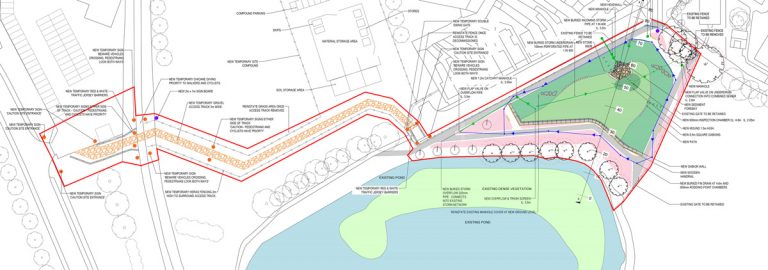
Cambrian North traffic management plan
Construction opportunities and challenges
Taking account of the condensed urban area in Llanelli, careful consideration was given to allow free flow of traffic during construction. Programmes were developed in collaboration with the local Highway Department and Stages 2-5 were planned consecutively to ensure minimal disruption to local residents.
The continuity of this approach also allowed a singular site compound, based in a redundant copper works factory, to be used to furnish the entire project. This saved on both the cost and carbon footprint of mobilising and demobilising.
A specific traffic management plan was developed for the Cambrian North scheme which involved managing the removal of 3,000m3 of earth and the import of the required basin materials. Due to the narrow streets a new access track created a separate route for construction vehicles, designed in discussion with residents, local businesses, the council and Sustrans. Measures were implemented to address the risks posed to local pedestrians and cyclists which included a pedestrian crossing, designated banksman and advance warning communications.
The basin mass haul exercise was appropriately planned removing the subsoil daily from the basin over a three-week period. The basin was then sequentially built up; with the below ground drainage, subsoil, gabion retaining walls and top soil installed; followed by the hard landscaping such as the benches, outfalls and paths. Specific planting was designed by the landscape architect to suit the area and low maintenance requirements.
The low lying area across the Cambrian catchment presented a particular challenge in regards to excavating around utility services and laying 8km of kerbs, channels and pipelines. Extensive desktop studies, trial holes and CCTV studies were undertaken to prove routes that ensured minimal service diversions were required. Whilst undertaking the works, multiple live and redundant uncharted services were also located that were carefully managed.
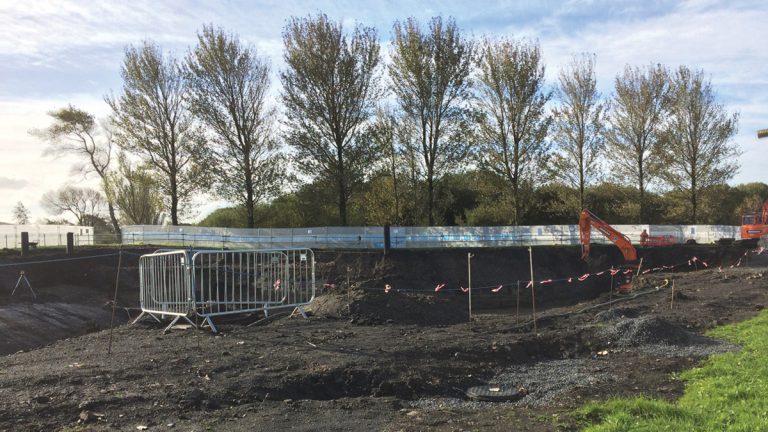
Cambrian North basin during excavation (October 2016) – Courtesy of Arup
Two new outfalls to the River Lliedi were constructed to take the surface water into the natural environment. The 500mm outfall at Cambrian South West proved a particular construction challenge because of the restricted period of working due to the tide limited the construction methods that could be used due to the existence of a listed wall and the presence of otters. A specific methodology was developed that incorporated erecting a false wall behind the listed wall complete with temporary works, coring through both walls and fixing the flap valve in a tidal working window.
Scour protection was also installed which consisted of a rock roll prefabricated mattress fixed to the mud bank with chestnut stakes from Salix River and Wetland Services.
The Cambrian Central Outfall consisted of a pre-fabricated head wall with large boulders for scour protection to stop erosion. Once again a methodology was developed to protect the ecological and environmental aspects of the surrounding area.
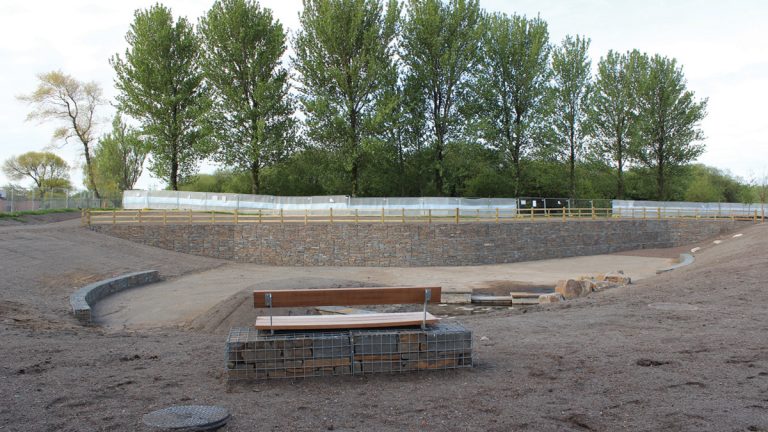
Cambrian North basin awaiting planting (May 2017) – Courtesy of Arup
Collaboration opportunities and challenges
Close collaboration with Carmarthenshire County Council has improved the delivery of the Cambrian schemes. Through regular, quarterly meetings, all council and Welsh Water stakeholders have been able to share knowledge and save time and money. One example of this is the use of existing council highway drains that have been utilised to save almost a kilometre of new pipework. Proactive land owner communication work led by Welsh Water’s dedicated estates department with active collaboration with Morgan Sindall and Arup ensured all stages of the scheme ran smoothly with minimum disruption to the land owners and local residents.
Additionally, engagement with the public was central to the project’s success with a dedicated drop-in centre available in the town centre for any questions. Public exhibitions were arranged and regular advance warning letters informed residents of the forthcoming work in the area.
There was a real sense of community engagement with the work force; examples included operatives unblocking an elderly woman’s drain, rescuing a small dog and helping the elderly across the street.
This enhanced the public acceptance of the work being undertaken with the contractor and neighbourhood working together. Multiple letters of thanks have been received from the local residents which exemplifies a culture of customer-led success.
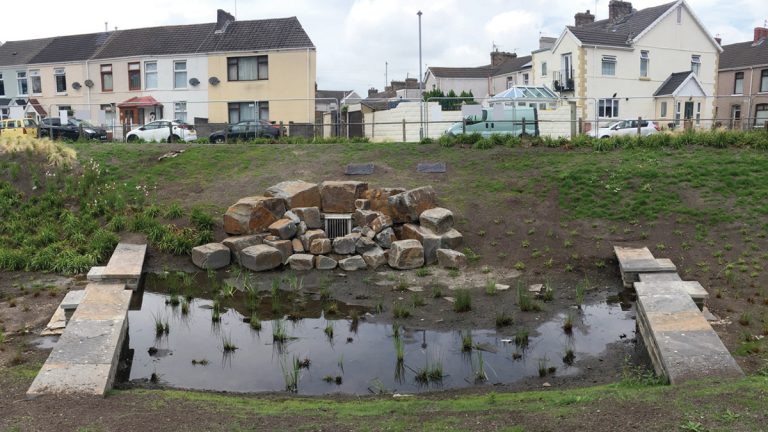
Surface water discharge headwall into energy dissipation zone – Courtesy of Dŵr Cymru Welsh Water and Morgan Sindall
Results
Cambrian RainScape construction is expected to be completed in July 2017. The full impact of the scheme on discharges at Cambrian SPS will be assessed using flow monitors and telemetry data through 2018 and 2019. Initial post-construction monitoring for Cambrian South West shows over 200l/s has been removed from the combined sewer, performing as predicted. This has further increased our confidence in RainScape as a high impact, affordable, sustainable solution in combined sewer catchments.
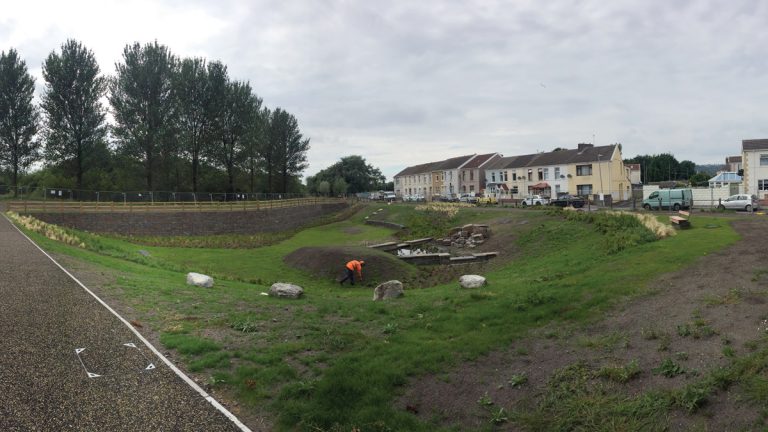
Cambrian Swale – Early stage plant growth – Courtesy of Dŵr Cymru Welsh Water and Morgan Sindall
It is anticipated Cambrian RainScape will reduce discharges at Cambrian SPS to 10 per year as well as reducing peak flows by 600l/s and the annual discharge volume by over 85%. As well as reducing pollution, the new surface water network has increased the resilience of both highway drainage and the foul sewer to flooding, climate change and future growth. Removing 125,000m3 of surface water from the combined system will also mean savings of £30,000 in operational costs and 6,000kg in carbon annually.
Cambrian RainScape was forecast to be delivered for £11.5m however the estimated actual costs are £7.9m. This saving has been driven by Welsh Water’s efficiency targets and been delivered through innovation by the design and construction teams.





